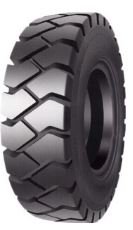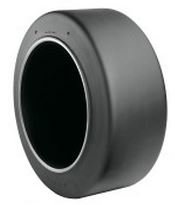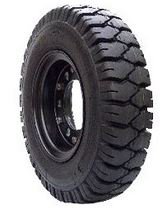Posts tagged ‘forklift tires’
What Forklift Tires & Options Do I Need?
Toyota provides a variety of options for your forklift. Depending on your specific application, some options may provide additional safety benefits for your workplace.
Tire Options
Forklift tires are available in three types: Cushion, Solid Pneumatic, and Air Pneumatic.
1. Cushion Tires are composed of solid rubber and are directly pressed onto the wheel. They sit lower to the ground and offer a smaller turning radius, which provides an advantage in maneuverability. Cushion Tires are primarily suited for indoor or paved applications as they can struggle on uneven surfaces like gravel.

2. Pneumatic Tires (Solid) are designed of solid rubber, much like a cushion tire and are the most common tire on the market today. Solid pneumatic tires are commonly used for a combination of indoor and outdoor applications. However, solid pneumatic tires do not offer the same comfortable ride a cushion tire does across paved surfaces. The initial investment is higher, but they are practically indestructible and have a very long life.
3. Pneumatic Tires (Air Filled) are designed of rubber, but are air filled much like a car or truck tire. They have a deep tread and are made of strong, long-lasting rubber material. These tires are better for rough outdoor terrain.
Although tires are an important component to the operation of the forklift, other options must be reviewed and considered before you make your purchase.
Application-Based Components
- Back-up alarms offer a clear warning to pedestrians when the operator is operating the forklift in reverse.
- Flashing Lights/Strobes/Rotating Beacons assist the operator in alerting pedestrians to the presence of the forklift.
- Mirrors offer extended visibility for the operator
Ergonomics
Ergonomics may seem like a luxury, but for an employee who spends their day on a forklift, adjustable seats, and comforts can reduce the risk of stress injuries and make for a more productive day.
Attachments
- Side shifters enable the operator to move the load left and right without moving the forklift. This allows the operator to place the load exactly where they require it.
- Side shifting Fork Positioner enables the fork spread to be adjusted from the driver’s seat eliminating the need to manually adjust the forks.
A wide variety of options are available for your forklift. Contact us to learn more and help determine which options will work best for your application.
The original content is located here.
Subscribe to Toyota Forklift’s blog here.
What you need to know about forklift tires
When selecting forklift tires, it’s crucial to consider your application, forklift model, and work environment. Various applications call for different forklifts and, consequently, different tire types. Read our blog post to discover answers to frequently asked questions about forklift tires and applications.
How do I choose the right forklift tires?
Your forklift’s wheels and frame are typically designed for a specific tire type, such as pneumatic or cushion tires. To ensure compatibility, consult your local dealer and the forklift’s manual.
Is it possible to switch forklift tires to a different type?
While it’s often possible to switch between similar tire types (e.g., smooth cushion to traction cushion or pneumatic to solid pneumatic), transitioning between cushion and pneumatic tires is rare.
When replacing tires, it’s important to ensure consistency on both sides of the forklift. While the front and back tires can differ, both front tires and back tires must be the same type. For instance, having a mix of smooth cushion and traction cushion tires on the same axle isn’t recommended; instead, opt for uniformity, such as two smooth cushion tires in the front and two traction cushion tires in the back.
What forklift tire is best for factory or indoor applications?
Cushion tires are ideal for indoor settings with clean floor surfaces. They offer longevity, enhanced maneuverability, and improved traction.
What type of forklift tire should we use outdoors in rough terrain?
Outdoor and rough terrain environments benefit from pneumatic or solid pneumatic tires to provide traction and stability on uneven surfaces.
What forklift tire is best for general warehousing and warehouse applications?
Warehousing tasks, especially those involving order pickers, often require polyurethane tires. These tires enhance stability and traction on warehouse floors.
What type of forklift tire should we use in a cold storage environment?
In cold or wet environments, polyurethane tires with microgrids or razor sipes are typically used for better traction and braking, especially in slick conditions.
What type of forklift is best for food storage or other sensitive applications?
Sensitive industries like food, paper, or printing often need non-marking tires to avoid cross-contamination issues caused by carbon black particles present in standard tires.
If you need assistance choosing or replacing your forklift tires, our material handling professionals can help. Contact us today to set up a free consultation with a forklift tire expert.
Want to upgrade your forklift with new tires at unbeatable prices? We have front and rear options available in cushion and pneumatic styles. Shop our tire sale now. The promotion ends June 30, 2024.
Why You Should Care About Forklift Tires
Forklift tires play a crucial role in forklift operations’ performance, efficiency, and safety. Here are six reasons why forklift tires are so essential:
Traction
Forklifts often operate in environments with various surfaces, including smooth warehouse floors, outdoor pavement, gravel, or even icy conditions. The right tires provide adequate traction, allowing the forklift to grip the ground securely and maneuver safely, especially when carrying heavy loads.
Stability
Forklifts carry substantial weight in the form of the loads they transport and their machinery. Properly selected tires contribute to the forklift’s stability, preventing tipping or sliding, which is crucial for the safety of operators and nearby personnel.
Load Handling
Different tire types suit various load capacities and handling requirements. Pneumatic tires are ideal for outdoor use and rough terrain, while cushion tires are better suited for indoor operations on smooth surfaces. Choosing the right tires ensures optimal load-handling capabilities and minimizes the risk of accidents.
Durability and Longevity
Forklift tires get a lot of use, resulting in heavy wear and tear in demanding industrial environments. Durable tires can withstand the rigors of daily use, reducing the frequency of replacements and maintenance downtime, thus contributing to overall operational efficiency and cost savings.
Operator Comfort
Forklift operators spend long hours behind the wheel, often navigating challenging terrain. Tires with appropriate cushioning and shock absorption properties provide a smoother ride, reducing operator fatigue and improving productivity.
Environmental Considerations
Forklift tires can impact environmental factors such as noise levels and emissions. Choosing eco-friendly tire options, such as electric forklifts with non-marking tires, can help minimize the carbon footprint and comply with workplace regulations.
In essence, forklift tires are not just rubber components; they are critical elements that directly influence forklift operations’ performance, safety, and efficiency. Investing in the right tires tailored to the specific needs of your workplace environment is essential for optimizing productivity and ensuring a secure working environment.
If you need help selecting or replacing your forklift tires, our team of material handling experts is here to assist you. Reach out today to schedule a complimentary consultation with one of our forklift tire specialists.
Want to upgrade your forklift with new tires at unbeatable prices? We have front and rear options available in cushion and pneumatic styles. Shop our tire sale now. The offer ends on June 30, 2024.



